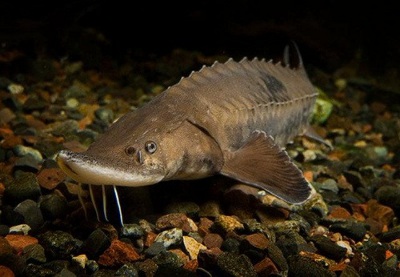Atlantic sturgeon
Category: Salt Water

Atlantic Sturgeon Fish, "Scientific name for Atlantic Sturgeon Fish is Acipenser oxyrhynchus". The Atlantic sturgeon is a long-lived, anadromus and an estuarine-dependent fish. Atlantic Sturgeon Fish is a member of the Acipenseridae family (Class Actinopterygii) and is one of the oldest bony fish species still existing in the world. The Atlantic Sturgeon Fish spend most of their time in saltwater and only enter freshwater when they want to spawn. The Atlantic Sturgeon Fish can grow to approximately 15 ft. (4.5 m) in length and a fully grown Atlantic Sturgeon Fish weighs up to 370 kg (800 pounds).
The Atlantic Sturgeon Fish is native to temperate, subtropical and sub-Arctic lakes, rivers and coastlines of North America and Eurasia. The Atlantic Sturgeon Fish are commonly found along the Atlantic coast from the New Brunswick, Canada to the eastern coast of Florida, including the rivers of Florida, where they are known to have injured people in boats.
The Atlantic Sturgeon Fish color ranges from olive-green and blue-black dorsally (on the back) to white on its belly and ventral side. There’s also a narrow and pointed tip on its snout that often becomes blunter as the fish ages. Atlantic Sturgeon Fish lower lip features a split in the middle and four slender barbels located halfway between the anterior edge of its mouth and the end of its snout. Atlantic Sturgeon Fish uses the barbels to locate prey. Its pupil is either gold or copper or bronze in color. The Atlantic Sturgeon Fish also has five main rows of big heavy dermal scutes. Scutes are the bony plates that cover the body of this fish species; they don’t have scales.
The Atlantic Sturgeon Fish species has really experienced an overall decline caused by water pollution and overfishing. In fact, in much of its original habitats, the Atlantic Sturgeon Fish has been threatened to be endangered and has even become extinct.
The Atlantic Sturgeon Fish spawns infrequently with the first spawning taking place between 6 to 30 years of age. Subsequent spawning normally occurs after every 3 to 5 years following sexual maturity. Once born, the younger Atlantic Sturgeon Fish stay in the river for at most 5 years before they move to coastal waters, where they then tend to stay close to the shore.

 Back To Category Salt Water
Back To Category Salt Water